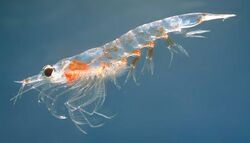Biology:Eucarida
| Eucarida | |
|---|---|

| |
| Meganyctiphanes norvegica, northern krill | |
| Scientific classification | |
| Domain: | Eukaryota |
| Kingdom: | Animalia |
| Phylum: | Arthropoda |
| Class: | Malacostraca |
| Subclass: | Eumalacostraca |
| Superorder: | Eucarida Calman, 1904 [1] |
| Orders | |
| |
Eucarida is a superorder of the Malacostraca, a class of the crustacean subphylum, comprising the decapods, krill, and Angustidontida.[2] They are characterised by having the carapace fused to all thoracic segments, and by the possession of stalked eyes.[3]
Orders
Eucarida is a diverse and abundant group, comprising the following four orders:
Euphausiacea
The members of the Euphausiacea are commonly called krill and are all marine shrimp-like species whose pleopods (abdominal appendages) function as swimmerets. They swarm and mostly feed on plankton. This group is composed of only 90 species, some of which are the most abundant species on the planet; in fact, it is estimated that the biomass of the Antarctic krillEuphausia superba' is 500 million tons.[4]
Decapoda
Decapoda is a group with 15,000 species[5] which have 5 pairs of thoracopods and a well-developed carapace that covers the gills (which are exposed in krill). They include lobsters, crabs, shrimp and prawns. The decapods are further subdivided on the basis of the gill structure into two suborders Dendrobranchiata (prawns) and Pleocyemata, which is further subdivided into several infraorders, such as the Caridea (true shrimp), the Stenopodidea (boxer shrimp) and the Anomura and the Brachyura (crabs) and so forth.[6][7]
Amphionidacea
In addition, there is an enigmatic eucarid species, Amphionides reynaudii, which is the sole representative of its order, but due to the loss of several features resulting from its small size, its classification has been unclear.[8]
Angustidontida
Lastly, there is an extinct order that contains only one family, Angustidontidae, which in turn contains two genera, Angustidontus and Schramidontus.[9] They were originally considered eurypterids, but later their possible relationship with decapods was established.[9][10]
Phylogeny
The phylogeny of the Malacostraca is debated.[6] In particular, the monophyly of Eucarida is also under question:
- Monophyletic: many argue that the Eucarida group is a clade, sister to the Peracarida clade[6][11] or to the basal Malacostraca.[7][12] or to Mysida (paraphyletic Schizopoda)[13]
- Paraphyletic: some have proposed a paraphyletic Eucarida forming a clade with a nested Peracarida.[14]
- Polyphyletic: some have grouped Euphausiacea with Mysida to form the Schizopoda,[15][16] or the Euphausiacea with the Hoplocarida,[17] with Decapoda basal to the Peracarida.[16][17]
References
- ↑ "Eucarida Calman, 1904". Integrated Taxonomic Information System. https://www.itis.gov/servlet/SingleRpt/SingleRpt?search_topic=TSN&search_value=95495.
- ↑ WoRMS (2010). "Eucarida". World Register of Marine Species. http://www.marinespecies.org/aphia.php?p=taxdetails&id=1089.
- ↑ L. A. Borradaile; F. A. Potts; L. E. S. Eastman; J. T. Saunders (1961). "The Class Crustacea". in Gerald A. Kerkut. The Invertebrata (4th ed.). Cambridge University Press. pp. 340–419.
- ↑ Joel W. Martin; George E. Davis (2001). An Updated Classification of the Recent Crustacea. Natural History Museum of Los Angeles County. pp. 1–132. http://atiniui.nhm.org/pdfs/3839/3839.pdf.
- ↑ Sammy De Grave et al. (2009). "A classification of living and fossil genera of decapod crustaceans". Raffles Bulletin of Zoology Suppl. 21: 1–109. http://rmbr.nus.edu.sg/rbz/biblio/s21/s21rbz1-109.pdf.
- ↑ 6.0 6.1 6.2 Frederick Schram (1986). Crustacea. Oxford University Press. ISBN 0-19-503742-1.
- ↑ 7.0 7.1 M. A. Wills (1998). "A phylogeny of recent and fossil Crustacea derived from morphological characters". Arthropod Relationships. Volume 55 of Systematics Association Series. Springer. pp. 189–210. ISBN 978-0-412-75420-3. https://books.google.com/books?id=Pj-q9eHyIx0C&pg=PA189.
- ↑ Richard C. Brusca; Gary J. Brusca (2003). Invertebrates (2nd ed.). Sunderland, Massachusetts: Sinauer Associates. ISBN 978-0-87893-097-5.
- ↑ 9.0 9.1 Gueriau, Pierre; Charbonnier, Sylvain; Clément, Gaël (2014-09-01). "Angustidontid crustaceans from the Late Devonian of Strud (Namur Province, Belgium): Insights into the origin of Decapoda". Neues Jahrbuch für Geologie und Paläontologie - Abhandlungen 273 (3): 327–337. doi:10.1127/0077-7749/2014/0434. https://www.researchgate.net/publication/265211942.
- ↑ T. A. Hegna, J. Luque, and J. A. Wolfe (2020). The fossil record of the Pancrustacea. In M. Thiel, G. C. B. Poore (eds.). Evolution and Biogeography of the Crustacea. 8. Oxford University Press. p. 21-52. https://www.researchgate.net/profile/Thomas-Hegna/publication/340983983_The_Fossil_Record_of_the_Pancrustacea/links/5f451633a6fdcccc43fe7f10/The-Fossil-Record-of-the-Pancrustacea.pdf.
- ↑ R. Siewing (1963). "Studies in malacostracan morphology: results and problems". Phylogeny and Evolution of Crustacea. Cambridge, Massachusetts: Museum of Comparative Zoology. pp. 85–103.
- ↑ Trisha Spears; Ronald W. DeBry; Lawrence G. Abele; Katarzyna Chodyla (2005). "Peracarid monophyly and interordinal phylogeny inferred from nuclear small-subunit ribosomal DNA sequences (Crustacea: Malacostraca: Peracarida)". Proceedings of the Biological Society of Washington 118 (1): 117–157. doi:10.2988/0006-324X(2005)118[117:PMAIPI2.0.CO;2]. http://decapoda.nhm.org/pdfs/10231/10231.pdf.
- ↑ L. Watling (1999). "Towards understanding the relationship of the peracaridan orders: the necessity of determining exact homologies". in Frederick R. Schram. Crustaceans and the Biodiversity Crisis. Proceedings of the Fourth International Crustacean Congress, Amsterdam: The Netherlands, July 20–24, 1998, Vol. I. Brill Publishers. pp. 73–89. ISBN 978-90-04-11387-9.
- ↑ Stefan Richter; Gerhard Scholtz (2001). "Phylogenetic analysis of the Malacostraca (Crustacea)". Journal of Zoological Systematics and Evolutionary Research 39 (3): 113–136. doi:10.1046/j.1439-0469.2001.00164.x.
- ↑ Georg Ossian Sars (1870). Carcinologiske Bidrag til Norges Fauna over de ved Norges Kysters forekommende Mysider. Vol. 1. Christiana: Brøgger & Christies Bogtrykkeri.
- ↑ 16.0 16.1 Simon N. Jarman; Stephen Nicol; Nicholas G. Elliott; Andrew McMinn (2000). "28S rDNA evolution in the Eumalacostraca and the phylogenetic position of krill". Molecular Phylogenetics and Evolution 17 (1): 26–36. doi:10.1006/mpev.2000.0823. PMID 11020302.
- ↑ 17.0 17.1 K. Meland; E. Willassen (2007). "The disunity of "Mysidacea" (Crustacea)". Molecular Phylogenetics and Evolution 44 (3): 1083–1104. doi:10.1016/j.ympev.2007.02.009. PMID 17398121. http://decapoda.nhm.org/pdfs/31293/31293.pdf.
Wikidata ☰ Q127341 entry
 |

